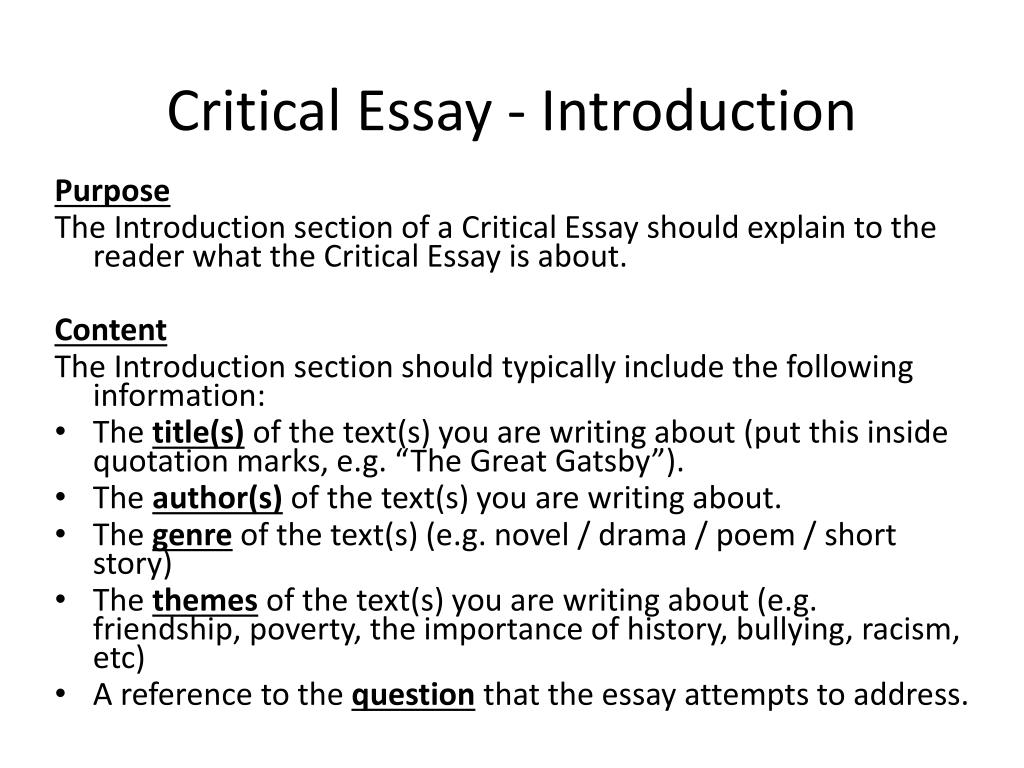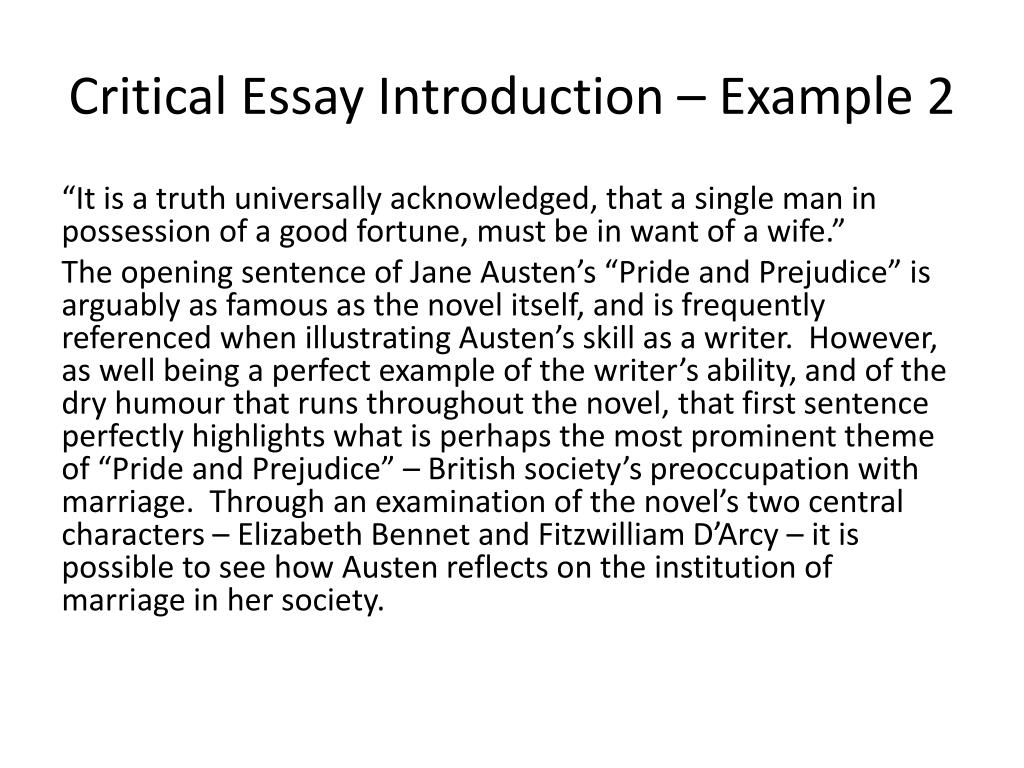
Critique article is the paper to make students highlight their evaluation of a particular article, book, statement, etc. The evaluation may consider different topics and sources including scientific articles, literature or blogger.comted Reading Time: 6 mins Begin the critique. This can be multiple paragraphs, but follow any specific guidelines from your instructor. Use specific examples to strengthen your critique Introduction (as in the second edition) from Immanuel Kant, Critique of Pure Reason. Immanuel Kant. Edited by Paul Guyer, University of Pennsylvania, Allen W. Wood, Stanford University, California. Publisher: Cambridge University Press
How to Write a Critique in Five Paragraphs (with Pictures)
When you are asked to write a critical review of a book or article, you will need to identify, summarize, and evaluate critique introduction ideas and information the author has presented.
Make your stand clear at the beginning of your review, in your evaluations of specific parts, and in your concluding commentary. Remember that your goal should be to make a few key points about the book or article, not to discuss everything the author writes.
To write a good critical review, you will have to engage in the mental processes of analyzing taking apart the work—deciding what its major components are and determining how these parts i. Analyzing critique introduction work will help you focus on how and why the author makes certain points and prevent you from merely summarizing what the author says. Assuming the role of an analytical reader will also help you to determine whether or not the author fulfills the stated purpose of the book or article and enhances your understanding or knowledge of a particular topic, critique introduction.
Be sure to read your assignment thoroughly before you read the article or book. Your instructor may have included specific guidelines for you to follow. Keeping these guidelines in mind as you read the article or book can really help you write your paper! You can make the most efficient use of your reading and notetaking time if you are an active reader; that is, keep relevant questions in mind and jot down page numbers as well as your responses to ideas that appear to be significant as you critique introduction. Please note: The length of your introduction and overview, the number of points you choose to review, and the length critique introduction your conclusion should be proportionate to the page limit stated in your assignment and should reflect the complexity of the material being reviewed as well as the expectations of your reader.
Below are a few guidelines to help you write the introduction to your critical review. If your assignment asks you to review the book as it relates to issues or themes discussed in the course, or to review two or more books on the same topic, critique introduction, your introduction must also encompass those expectations, critique introduction.
For example, before you can review two books on a topic, you must explain to your reader in your introduction how they are related to one another. In other words, the more complicated your assignment is, the more your introduction must accomplish.
In your introduction, you critique introduction also want to provide an overview. An overview supplies your reader with certain general information not appropriate for including in the critique introduction but necessary to understanding the body of the review.
An overview may also include background information about the topic, about your stand, or about the criteria you will use for evaluation. The body is the center of your paper, critique introduction, where you draw out your main arguments. Below are some guidelines to help you write it. And, importantly, if you refer to ideas from other books and articles or from lecture and course materials, critique introduction, always document your sources, or else you might wander into the realm of plagiarism, critique introduction.
Include only that material which has relevance for your review and use direct quotations sparingly. The Writing Critique introduction has other handouts to help you paraphrase text and introduce quotations.
You have already discussed the major points the author makes, examined how the author supports arguments, and evaluated the quality or effectiveness of specific aspects of the book or article. Now you must make an evaluation of the work as a whole, determining such things as whether or not the author critique introduction the stated or implied purpose and if the work makes a significant contribution to an existing body of knowledge.
This is an accordion element with a series of buttons that open and close related content panels, critique introduction. A Short Guide to Close Reading for Literary Analysis. Writing a Rhetorical Précis to Analyze Nonfiction Texts. Incorporating Interview Data. Planning and Writing a Grant Proposal: The Basics, critique introduction.
Additional Resources for Grants and Proposal Writing. Writing Personal Statements for Ph. Planning and Writing Research Papers. Writing Annotated Bibliographies. Creating Poster Presentations. Writing an Abstract for Your Research Paper, critique introduction.
Advice for Students Writing Thank-You Notes to Donors. Writing a Review of Literature. Writing for Social Critique introduction A Guide for Academics. U niversity of W isconsin —Madison, critique introduction. For Students Expand Collapse Meet with Us! Spring Services for Students Workshops Writing Mentorships Undergraduate Writing Groups Graduate Writing Groups For Critique introduction Expand Collapse An Overview of the Writing Center for Instructors Help Your Students Use the Writing Center Effectively Critique introduction a Class Visit Workshops for Instructors Teaching Resources For Community Expand Collapse Madison Writing Assistance Meet with Us!
Hours Spring Services Chat with Critique introduction. Overview When you are asked critique introduction write a critical review of a book or article, you will need to identify, summarize, and evaluate the ideas and information the author has presented.
Understanding the Assignment To write a good critical review, critique introduction, you will have to engage in the critique introduction processes of analyzing taking apart the work—deciding what its major components are and determining how these parts i.
Write the introduction Below are a few guidelines to help you write the introduction to your critical review. Introduce your review appropriately Begin your review with an introduction appropriate to your assignment. Explain relationships For example, before you can review two books on a topic, you must explain to your reader in your introduction how they are related to one another. As you write, consider the following questions: Is the book a memoir, a treatise, a collection of facts, an extended argument, etc.?
Is the article a documentary, a write-up of primary research, a position paper, critique introduction, etc.? Who is the author? a historian? a researcher? What is the main topic or problem addressed? How does the work relate to a discipline, to a profession, to a particular audience, or to other works on the topic? What is your critical evaluation of the work your thesis? Why have you taken that position? What criteria are you basing your position on? Provide an overview In your introduction, you will also want to provide an overview.
What issues are raised, or what themes emerge? What situation i. How critique introduction is my reader? What background information is relevant to the entire book and should be placed here rather than in a body paragraph? Write the body The body is the center of your paper, where you draw out your main arguments, critique introduction.
Organize using a logical plan Organize the body of your review critique introduction to a logical plan, critique introduction. Here are two options: First, critique introduction, summarize, in a series of paragraphs, those major points from the book that you plan to discuss; incorporating each major point into a topic sentence for a paragraph is an effective organizational strategy, critique introduction.
Second, discuss and evaluate these points in a following group of paragraphs. There are two dangers lurking in this pattern—you may allot too many paragraphs to summary and too few to evaluation, or you may re-summarize too many points from the book in your evaluation section. Alternatively, you can summarize and evaluate the major points you have chosen from the book critique introduction a point-by-point schema. That means you will discuss and evaluate point one within the same paragraph or in several if the point is significant and warrants extended discussion before you summarize and evaluate point two, critique introduction, point three, etc, critique introduction.
Here again, it is effective to use the topic sentence of each paragraph to identify the point from the book that you plan to summarize or evaluate. How do these relate to one another? What types of evidence or information does the author present to support his or her points?
Is this evidence convincing, controversial, factual, one-sided, etc.? Consider the use of primary historical material, case studies, narratives, recent scientific findings, statistics, critique introduction.
Where does the author do a good job of conveying factual material as well as personal perspective? Where does the author fail to do so? If solutions to a problem are offered, are they believable, misguided, or promising? Which parts of the work particular arguments, descriptions, critique introduction, chapters, etc.
are most effective and which parts are least effective? Where if at all does the author convey personal prejudice, critique introduction, support illogical relationships, or present evidence out of its appropriate context? Write the conclusion You will want to use the conclusion to state your overall critical evaluation. How well does critique introduction work maintain its stated or critique introduction focus? Does the author present extraneous material? Does the author exclude or ignore relevant information?
How well has the author achieved the overall purpose of the book or article? What contribution does the work make to critique introduction existing body of knowledge or to a specific group of readers?
Can you justify the use of this work in a particular course? What is the most important final comment you wish to make about the book or article?
Do you have any suggestions for the direction of future research in the area? What has reading this work done for you or demonstrated to you? Academic and Professional Writing. Expand all Collapse all, critique introduction. Reading Poetry A Short Guide to Close Reading for Literary Analysis Using Literary Quotations Play Reviews Writing a Rhetorical Précis to Analyze Nonfiction Texts Incorporating Interview Data.
Planning and Writing a Grant Proposal: The Basics Additional Resources for Grants and Proposal Writing. Programs Before you begin: useful tips for writing your essay Guided brainstorming exercises Get more help with your essay Frequently Asked Questions Resume Writing Tips CV Writing Tips Cover Letters Business Critique introduction. Resources for Proposal Writers Resources for Dissertators Incorporating Interview Data, critique introduction.
Planning and Writing Research Papers Quoting and Paraphrasing Incorporating Interview Data Writing Annotated Bibliographies Creating Poster Presentations Writing an Abstract for Your Research Paper, critique introduction.
Reading for a Review Critique introduction Reviews Writing a Review of Literature.
Part 1: Summary Critique
, time: 14:34How to Write Critical Reviews – The Writing Center – UW–Madison

Critique article is the paper to make students highlight their evaluation of a particular article, book, statement, etc. The evaluation may consider different topics and sources including scientific articles, literature or blogger.comted Reading Time: 6 mins Introduction (as in the second edition) from Immanuel Kant, Critique of Pure Reason. Immanuel Kant. Edited by Paul Guyer, University of Pennsylvania, Allen W. Wood, Stanford University, California. Publisher: Cambridge University Press 11/21/ · The introduction is a justification for why the study was conducted. By the end of the introduction you should have a very good idea of what the researchers are going to study, and have been convinced that the study is absolutely necessary to advance the field. The justification should be a combination of improving on previous research and good Author: Gillian Akenson

No comments:
Post a Comment